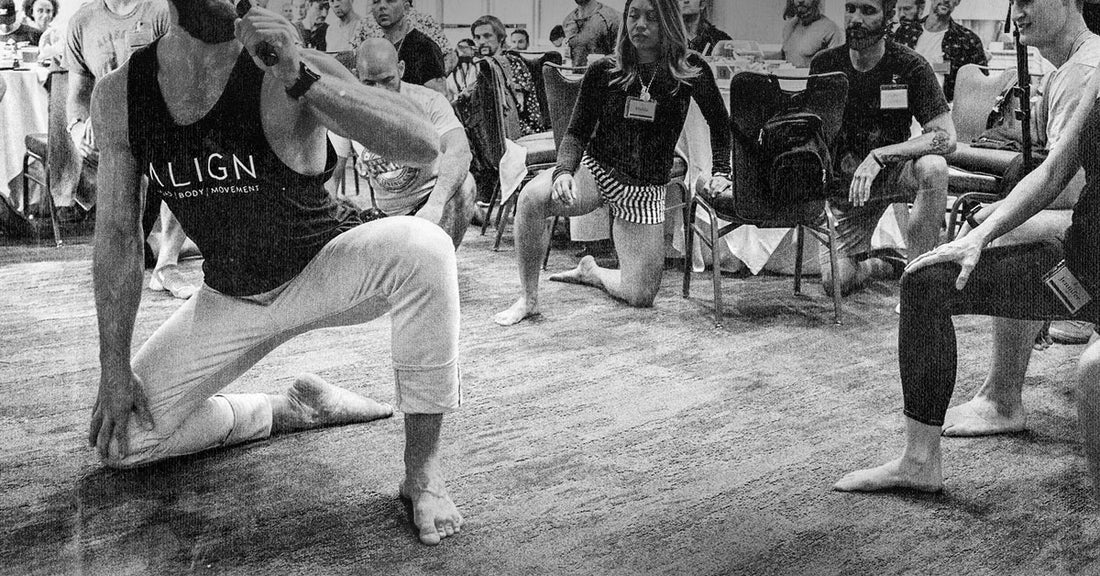Does anyone else find the abundance of chair-sitting-based exercise equipment in gyms a bit redundant, as though we don’t practice that position enough in modern culture as it is? Let’s paint a quick picture of most people’s daily leg and hip use: We bend slightly to roll out of a raised bed, wake up and walk out to the kitchen where everything is conveniently placed at hip level or above, removing the need to squat, or even hip-hinge for that matter. Hopefully, at some point you drop a deuce by sitting at 90 degrees on a raised toilet, then shuffle out to the car, bus or train to sit in the same posture. Next, it’s off to work, where you most likely assume the repetitive position once again, but now in either a prestigious leather chair or whatever crummy butt retainer is provided by your employer (or perhaps you’re progressive and have a standing desk). For most of us, that pattern just continues throughout the day. Rarely are we hinging our hips or bending our knees past 90 degrees.
People raised in the Blue Zones of the world (a term popularized by author Dan Buettner for locations with a high percentage of centenarians) are certainly movers, but generally, they don’t care much about traditional gym exercise. Instead, movement is baked into each day: Tending to a garden works in squats, lunges and kneeling movements, walking to town for groceries gets the whole bottom half of the body moving, while impromptu games of street soccer provide fast-changing pivots at the knees and ankles. Exercise is an abstract waste of energy from much of the world’s perspective.
Floor sitting is a simple, realistic and effective way to add more functional movement into your daily life. When sitting on the floor, you’re forced to move your joints through their full range of motion. If you sit on the floor while drinking your morning coffee, working and eating, can you imagine many times a day your joints would experience more than their average range of mobility?
So, how has the rest of the world (for thousands of years) rested and/or worked on projects from the ground, you ask? Here are some fundamental floor sitting positions specifically designed to mobilize your joints and bring your whole body back into tune—during and after the stress of the day.

Easy Pose (Sukhasana)
The word “Sukhasana” is derived from the Sanskrit word sukha, meaning pleasure or comfort, and asana, meaning pose. Remember “criss-cross applesauce,” Indian pose, or the W sitting position from elementary school, before your hips froze over like Shackleton’s Antarctic journey from excessive desk sitting? This tightening is not a natural part of becoming an adult. It’s a perversion of our structure, a maladaptation from a dysfunctional movement mold.
The cross-legged position is shown to help mobilize tight hips, disengage overly-tight hamstring muscles and assist in reactivating the butt muscles. This may have something to do with why yogis have spent so much time in this position for literally thousands of years (well, not in a row, but you get the point). It also helps relax and expand your breath, calm your nervous system, facilitate better circulation and make you superficially appear more conscious or woke to people who care about that sort of thing.
90/90 Position
The name refers to your legs being at 90-degree angles at both knees and both facing the same direction like two spokes of a pinwheel (a symbol for the sun, well-being, prosperity and good luck). This position is a great way to mobilize both medial and external rotation of the hip joint. Try alternating between the 90/90 and easy pose throughout your sitting practice at 10-minute intervals.
For the overachievers out there who would like to make this a more active position, play with raising your back-facing leg up off the ground as high as you comfortably can. Then, pulse it there for 10 repetitions. Then switch legs. You could step it up and make things even more challenging by raising the leg up and rotating the foot up toward the ceiling, creating a medial rotation from your femur (thigh bone). Finally, you can actively press both feet down into the ground for 10 seconds, creating an isometric contraction on both sides.

Kneeling (Japanese Style, or Seiza)
This is one of the standard positions you’ll see in many martial arts studios around the world. It’s a great practice for mobilizing the knee joint and its surrounding tissues, opening the feet up into the plantar-flexion (toe point) position and stacking the spine. Perhaps this is why in Japanese, this position is referred to as seiza, meaning “correct sitting.” You can add a pillow or cushion between your butt and ankles if you experience any discomfort in the knees. Start with as much cushion as you need to feel comfortable and slowly work your way down to none.

Toe Sit
This position has been one of the most valuable sitting postures to heal my own knees and ankles after years of discomfort. Oftentimes, knee issues are the upstream effect of imbalanced feet; this position is a fantastic check-in on toe and plantar fascia mobility. Your feet have about a zillion possible ranges of motion and modern shoes act as a huge limiting factor to your potential foot mobility.
Start from the kneeling position with your knees on a cushion and bring your hands to the ground so you can raise your feet up off the floor. Spread your toes wide and bring them down to the ground as far forward toward your knees as you comfortably can. Once your toes are pressed onto the ground, slowly sit down on your heels (be gentle with this and feel free to place a pillow or cushion between your butt and heels to make it easier). This will likely be uncomfortable to most people at first, but ease your way into it and remember what the Greek poet Hesiod said, “If you add a little to a little and do it again, soon that shall be much.”

Straddle
An elite gymnast friend recently mentioned to me that she rarely—if ever—sets aside time to actually stretch. She spends time in this exact position of repose while reading or watching Netflix and is one of the most flexible people I know. The straddle position is a standard for any gymnast and is super-helpful for opening up those tight calves and hamstrings you hear everyone complaining about. Remember to stay stacked on the front edge of the sit bones (ischial tuberosities) and feel free to stack your butt up on a cushion to be sure you stay on that sweet spot. If you’re stacked, this position should feel comfortable. If you can’t sit in this position without your pelvis tucking under, raise your butt with cushions until you can. For less flexible people, this may be a position to build into with time.
With whatever position you choose, remember to make the ground comfortable with rugs and cushions. As a general rule: Raise the height of your hips above your knees while sitting so that if you placed a ball on your thigh, it would roll down toward your knees. This will stack your spine to make floor sitting more therapeutic and pleasant over greater amounts of time.
Now you know how to floor sit, I have a challenge for you: Each day for the next 30 days, devote at least 30 minutes to “floor culture.” Spend some time on the floor in whatever fashion fits your fancy. You could read, watch TV, check emails, or anything of the sort. Just sit on the floor!
Aaron Alexander is a body movement and posture expert. He is the author of The Align Method, hosts the Align Podcast and is the founder of The Align Method Online Program. Stay up-to-date with Aaron via his website or follow him on Instagram.
Header image by Zack Embree.




